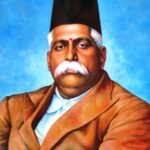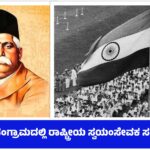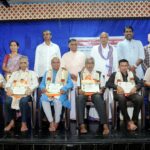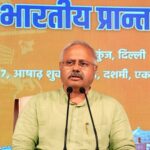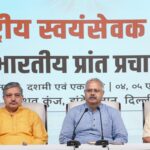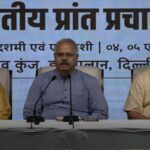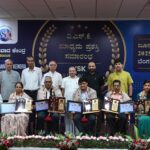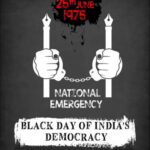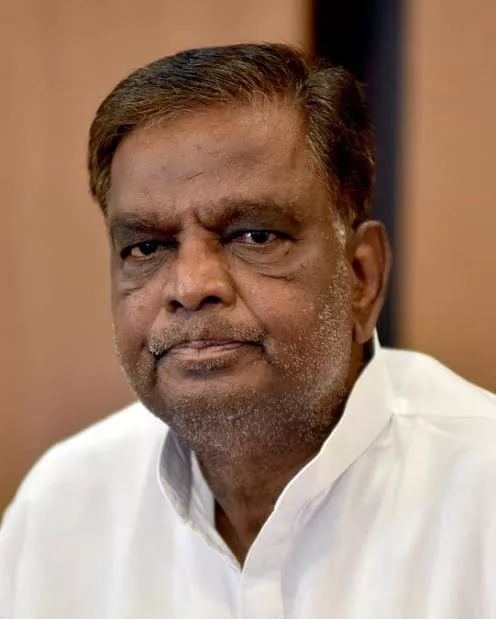
( Sri Srinivas Prasad, veteran politician, Ex lokasabha MP, C entral minister and a renowned Dalit leader from Karnataka passed away on 30th April 24.
Sri Vadiraj, a senior Karyakartha of RSS wrote this blog in kannada in his face book account )
Ashokapuram is a locality in Mysore city – Known as the epicentre of Dalit movement in Karnataka. All most all families living there are from backward communities. Senior politician V Srinivas Prasad who left us yesterday was born and brought up in Ashokapuram.
Those were the days of 1957 – 58 when Vijaya Shakha ( unit of ) RSS was started at Ganesha Park which is little far away from Ashokapuram.
Ramakrishna from Ashokapuram was the first to attracted towards RSS shakha. Venkataramu( who in his later years served as president of Karnataka RSS for more than a decade ), and Srinivasa Prasad are those two who accompanied him later. These three are childhood friends ( chaddi dosts) who were seen together always. With them followed other young kids from Ashokpuram colony….Javarayya, Muddu Chaluvayya, Vurgi Javara, Raghunath, Mahadeva, Venkataraju, Ramaswamy, Chikkaveerayya, Chamundi Mahalingu, Narayanaswamy, Srikantha, Siddappaji, Channarasu, Govindaraju, Vasu, Gangadhara…
This is how a big group of friends started to attend Vijaya Shakha of RSS.
‘Hanuman shakha’ in Ashokapuram was started a little later as the skills to run a shakha of RSS were gradually mastered by these swayamsevaks from that locality. Till the present day, Srinivasa Prasad used to talk about those memories of RSS – with his childhood friends. , ‘Vijaya shakha- Hanuman shakha would appear again and again in his chats.
Srinivasa Prasad has recorded 15 years of his early acquittance with RSS in the book Swabhimaaniya nenapugalu ‘(memories of self-esteem). He writes about Yadavarao Joshi, H V Sheshadri, N Madhwa rao, Haribhavu Vaje, Venkanna – The love, care, and encouragement shown by these RSS functionaries of his days, the month-long training camps of sangh which he attended twice, ABVP National Conference held in Kolkata and the thrill he experienced there by listening to thought-provoking speeches – all have been penned in this book elaborately.
In summer vacation, he went to Kampalapura, Chilkunda, and Kandegala villages for 15 days with Venkataramu to expand the organisational work and open new RSS shakhas. RSS shakha’s daily attendees included Vokkaligas, Lingayats, Dalits and different sections of the society, all coming together to play and sing with joy in shakha routines; these pictures would form most Beautiful memories of Srinivas Prasad. He writes – The games played in RSS shakhas would remove all types of anomalies in us in its own unique way . ‘I have never seen the slightest form of casteism in those fifteen years of my RSS life – This is Srinivas Prasad’s clear words. ( Page 41) It was natural that Srinivasa Prasad developed the qualities of leadership in RSS Shakha. In later days it would help him in politics also. A K Subbaiah, then state secretary of Jan Sangh ( earlier avatar of bjp ) stood for Southwest graduates constituency ( MLC )in Mysore in 1968, won and entered the upper house. In that election, Srinivas Prasad was his election agent.
Even after he entered the world of
Dalit -boosa- movement ( there was a turning point in Karnataka’s Dalit movement which is famously known as BOOSA INCIDENT ) he continued to have his close relationship with RSS. In 1989, during RSS founder Dr Hedagevar’s centenary celebrations – although he was a Congress MP then – Srinivasa Prasad shared the stage with RSS chief Balasaheb Deoaras in a public program held at Mysore Town Hall grounds.
Casteism and untouchability.- these are two things which bothered him deeply throughout his life. He would discuss hours together about these things ( including with the author of this write-up ).
His vast experience in the social field and the deep urge he had in his heart for a harmonious society would make the discussions more intense. ‘RSS is the only organisation that can bring equality and harmony among Hindus. Only Sangh has that power. The rest can just talk about this problem. But ….Sangh is very slow in this. Thus the Dalits who are in real pain of untouchability can not agree to this slow pace. This is my problem with Sangh. Huge tasks like social harmony can’t be achieved by some symbolic initiatives. Payasam served at the tip of the leaf will not fill your stomach – that’s the way Srinivas Prasad would explain his thoughts to the author.
In the companionship of his childhood friend Venkataramu, Srinivas Prasad would dive deep into his old memories and most of the time he would become emotional also. One of the incidents shared by Prasad with Venkatramu is thought-provoking.
In 1980 – Srinivas Prasad was elected to Loksabha for the first time. He visited a village in Chamarajnagar reserved constituency to express his gratitude to the people who supported him. In that village, there were only two communities. Upparas and Dalits. Village leaders had one major demand. They wanted their newly elected MP to pursue forest department officials not to create hurdles for them when they collect firewood from the jungle for their village festival. Village festival had an unique ritual of “ kenda haayuvudu” – devotees would walk over the burning live coal with their bare feet. Srinivas Prasad made that provision by instructing forest officials.
On the day of the festival when he visited the village he was shocked to see two separate arrangements, one for the Uppara cast and another for Dalits (for that “kenda haayuva “ritual). Got angry, and when he enquired why they didn’t have a single arrangement, one elder from the uppara cast said “It is not possible sir … we can’t allow Dalits to touch our kenda ( glowing coal)“
Srinivas Prasad would quip angrily “Their feet don’t get burnt when they walk on the fire of live coal but it will get hurt if Dalits touches it ”
He would be worried- how to educate these villagers about the complexities of untouchability?
‘Bheemasadana’ is the Srinivas Prasad’s house at Jayalakshmi Puram. Saint Raghavendra Swamy’s Mutt is situated two roads away from his home. Once Pejawar Swamiji was staying in that mutt. A board on the wall which had donor list of that mutt caught his attention. Swamiji enquired with his associates about one name – Bhagyalakshmi Srinivas Prasad in that list. He came to know that she is the wife of MP Srinivas Prasad. Pejawar Swamiji without any prior information or formality , straight away went to meet the Srinivas Prasad couple in their home. Srinivas Prasad was very glad and later he would say “ The strong voice with which Pejawar Swamiji spoke on that day about eradication of untouchability gave me some hope. All other Swamiji s should emulate him. Only Sangh can make them do this. “
In 1959, then railway minister Babu Jagjeevan Ram came to Ashokapuram and laid the foundation stone for Siddhartha residential school. A boy who listened to his speech sitting on the grounds in front of the stage on that day would enter the parliament 20 years later and will also Participate in the proceedings sitting next to Babuji.
This is the greatness of India’s democracy! The glory of Babasaheb Ambedkar’s constitution !!
Srinivas Prasad is not with us, but his words of experience and his intense urge to bring social harmony and equality in our mother society will always show us the way to achieve it.
